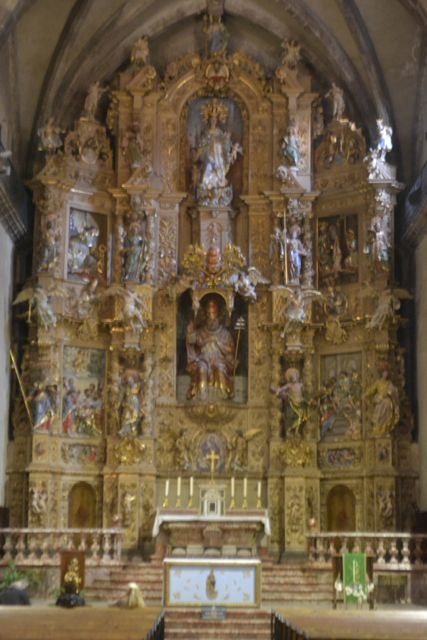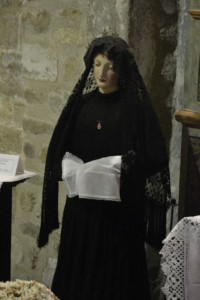Churches are like your granny’s house. They’re full of old furniture, pictures, and memories. A granny saves these things for a family. A church saves them for a country. They’re unique collections that reveal something about the people who’ve been there.
Every house has one primary room where the heart beats. Usually it’s where the family congregates. At my grandma’s, it was the kitchen. However, this room can also be behind a firmly closed door where nobody goes because something is there. It was the dining room at my great aunt’s house.(They were rumoured to be violent.) These rooms tell the most about a family. Churches are like your granny’s house but more specifically, they are like these rooms in a Granny’s house. They reveal something of the heartbeat of a country.
England
 British churches are like a grannie’s sitting room – crowded with overstuffed chairs, ottomans, tapestry pillows, dime store knick-knacks and with a half-finished puzzle on a TV tray in the corner.
British churches are like a grannie’s sitting room – crowded with overstuffed chairs, ottomans, tapestry pillows, dime store knick-knacks and with a half-finished puzzle on a TV tray in the corner.
They’re cosy as a crumpet. The kneelers are padded with needlework cushions stitched by a hundred years of grannies. Prayer books are stacked haphazardly on tables along with copies of “Hello!” magazine. Hairpins and a few buttons are in the poor box and you wouldn’t be surprised to see a large toad in a waistcoat practicing the organ.
No other country shows the intimacy of war like England. Threadbare regimental flags from the great wars hang in side chapels. They are faded but still show stains of sacrifice. The statue on the memorial looks like a boy named Kip who worked in the dairy. These chapels seem to be assembled by mothers with trembling hands. One last time she tucks her son into bed. Medals, coins, gilt boxes and tiny frames containing a photo or lock of hair crowd together on display. Sweet antique sentiments are cross stitched on small cushions and heavily embroidered banners gather dust.
All the old jolly goods come together in a British church. Chaucer and Shakespeare resonate in the Book of Common Prayer. Little Dorritt sang from the Oxford Book of Carols and William Morris lent a hand at decorating. Churchill taught us how to mourn. There’s no incense but the ancient oak beams smell like wax jackets, a hound and a sherry. Jane Austen and Monty Python have supplied the vicar. Needlework and padding provided by the Woman’s Institute.
France
 In France, churches are like grannie’s seldomly used dining room. The door is usually closed and nobody goes in there much. Dim light filters through net curtains onto fading photographs of dead relatives. A tray of walnuts is drying on the old cracked cupboard. Extra chairs are stacked in the corner for when the family comes. The poinsettia from last christmas loses it’s last leaf in the window.
In France, churches are like grannie’s seldomly used dining room. The door is usually closed and nobody goes in there much. Dim light filters through net curtains onto fading photographs of dead relatives. A tray of walnuts is drying on the old cracked cupboard. Extra chairs are stacked in the corner for when the family comes. The poinsettia from last christmas loses it’s last leaf in the window.
In most churches, the stations of the cross are plaster casts or carved stone or wood. French churches have elaborate framed engravings from the last century. Granny cut them out of a Gazette in her youth. The bible characters are dressed for the king’s ball. The ladies wear corsets and evening dresses and the men sport high boots and cravats. Generally these engravings are black and white but sometimes they’ve been luridly coloured. Many are water-stained, mouldy and spooky.
French war chapels are chilly and emit a whiff of the French revolution. The rooster, the national symbol, tops the stone memorials and crows out “Le mort pour France” The names of the dead soldiers are carved beneath but there’s no poem. There are no cushions. They aren’t sentimental at all and could have been assembled by Madame LeFarge and the mobs who knocked the heads off the cloister capitals in monasteries. Possibly I’ve seen too many desecrated churches to judge but who better to represent the French revolution than a farm yard animal?
Storage is an evident problem in French churches. Wooden benches are stacked behind the alter and folding chairs line the walls of side chapels. In a niche where a saint used to stand, brooms, mops, and dust cloths are tucked away. French churches have lots of artificial plants. At St. Point, there was a very convincing spider plant in the holy water font. In one church, the confessional booth stored a whole year of seasonal flower arrangements.
French churches are melancholy places. The French remain a little cagey about Rome’s power and aren’t sure if the churches belong to them or not. There’s a sense of remembered devotion, regret and obligation to the past but nobody comes regularly to pray or tidy up.
Spain
In Spain, the churches are like grannies’s best parlour. They smell of polish and wax and stand ready for holidays or when important guests visit. All of the best silver and plate is out on show and exhibited to best advantage. The most valuable are behind glass in curio cabinets, safe from the grandchildren.
 Some of her possessions are in the best possible taste – lovely early romanesque madonnas and crucifixes. However many others suggest there may be circus performers in the family. Gaudy altarpieces fill the chapels. Saints, angels, demons, city officials, cupids, nymphs, revered priests and peasants crowd together in riotous tiers from the floor to ceiling. They are wearing their best festival clothing; bright red, peacock blue and flashing gold. They remind me of dutch calliopes. Any minute I expect St. Peter to ring a little bell or the Virgin Mary to give us a Moulin Rouge kick.
Some of her possessions are in the best possible taste – lovely early romanesque madonnas and crucifixes. However many others suggest there may be circus performers in the family. Gaudy altarpieces fill the chapels. Saints, angels, demons, city officials, cupids, nymphs, revered priests and peasants crowd together in riotous tiers from the floor to ceiling. They are wearing their best festival clothing; bright red, peacock blue and flashing gold. They remind me of dutch calliopes. Any minute I expect St. Peter to ring a little bell or the Virgin Mary to give us a Moulin Rouge kick.
Spain avoided the great wars and so churches don’t have war chapels. Instead, they have assemblies. The church has so many statues, it doesn’t know what to do with them all. This granny just can’t throw anything away. The overflow assemble in chapels at the back of the church. and line the walls like strangers at a cocktail party. From different centuries and backgrounds, they don’t know each other, have nothing to say and just stand around looking for a drink. They aren’t even the same scale. A 6-foot St. Xavier stands next to an 18-inch St. Teresa. But they mean something to granny or were a gift from a neighbour, so they’re all out on show.

Yet, even this crowd is not enough. In some churches the exhibits are brought to greater drama with plaster mannequins. Shop window ladies are dressed up in real clothes to mourn, assist Jesus or just be more comfortable. They wear beautiful period clothing from around the turn of the century and I can only assume Granny thought it was too good to be hidden away in a cupboard.
Spanish churches are proud of their culture and show their family devotion. Although silent, it’s almost possible to hear the noisy chatter of los Ramblas. There’s always an elderly lady hovering in church to give you another helping of paella or tell you to stand up straight.
I suppose I could go on…Italian churches are like granny’s attic, American like the family “rec” room, Irish like the wood shed out back, Dutch like the ecumenical chapel at your Granny’s nursing home. Countries do a lot of soul searching about national identity. One place they could find it is in their churches.



Shelly Heideman says
What an amazing analogy! I want to hear more – tell me about the other country’s church grannies, Julie!!!!